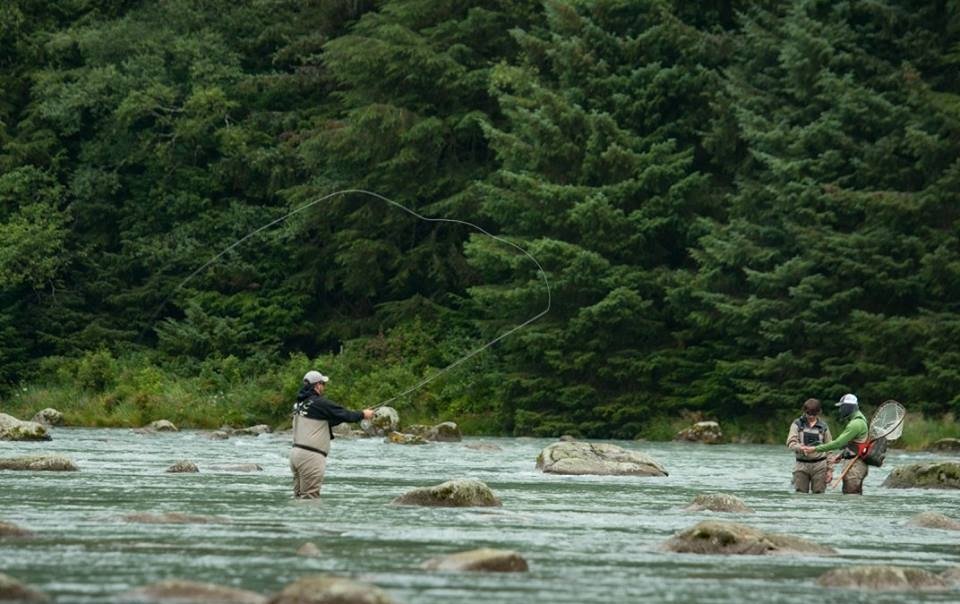
Frequently Asked Questions
FAQs
-
May & June: 5 or 6 weight single hand rods with sink tip lines
Late June - October: 8 weight single hand rods with sinking lines
We have a fleet of Sage and Orvis rods, with reels from Orvis & Waterworks-Lamson
-
We have a full line of Simms Gore-Tex waders and provide waders and wading boots for the trip; We’ll request sizing at time of booking; We have kids sizes all the way through to XXL adults; Boots sizes 4 to 16!
-
Mostly streamers and attractor patterns. We typically swing flies in the current with single hand rods, strip streamers or nymph fish with bead rigs.
-
We do not rent waders or fly rods; Our gear is dedicated to our clients. Unfortunately, no one in town does at this time.
-
May to Mid-June: Our season starts with dolly varden moving into the rivers from the lakes and saltwater to feed on outmigrating salmon fry/smolt. The fishing can truly be fantastic, with dollies hitting streamers multiple times in a swing. We use lighter rods for this time of year and fish the main currents of rivers. Dollies can range in the 12-24” range during the Spring. By mid-June we start seeing our first Sockeye salmon moving into fresh water.
Mid-June to Early July: Sockeyes continue showing up in larger quantities through late June with the run peaking in mid to late July. We switch to 8 wt rods for this time of year, in case we hook a sockeye. Dolly fishing continues to be strong through early July.
Early July-Late July: Peak sockeye season and big, fresh pink salmon start to be caught. Sea-run dolly varden are also in the mix, especially if there is a substantial pink salmon run.
August: Early August still has a solid sockeye run, but pinks are filling the rivers. Pink salmon can be really fun as they are aggressive and feisty for flies and will hit just about anything pink.
September: Early in the month we’re still fishing for pink salmon and dolly varden, and by mid-month, given good water levels, we can transition to chum and coho fishing. Coho fishing usually begins in earnest by the end of September as the glacial rivers start clearing up.
October: A special time of year in the Haines region. Miles of river to chase coho as the snow begins to come down the mountains. One of the primary reasons we live here. Jetboat and hiking access offer a diversity of water to fish.
-
We do not supply rain gear, but definitely recommend bringing a rain jacket!
-
Water bottle; Light Snack; Baseball cap or wool hat; Dress in layers as the river is cold, even on the warmest days; Rain jacket; Sunglasses (preferably polarized) to protect your eyes and cut down on glare on the water.
-
Simms Gore-Tex Waders, Fly Rods/Reels (Orvis, Sage & Lamson/Waterworks), Hand-Tied Flies, Instruction, Snacks & Drinks; Full day includes lunch
-
Visit ADFG Licenses and Permits to purchase a non-resident fishing license. A one day license works great unless you’ll be fishing elsewhere in Alaska. Please print and sign the license and bring it with you, or have an image of a signed copy on your phone.
-
Gratuity is not included, but is very much appreciated. Our guides work hard and we hope to deliver a fantastic experience, regardless of how the fishing is on any given day. Cash tips are preferred.
-
Once all timing is confirmed for your day of fishing, you will receive an invoice by email via Square Up. Payment can be made easily and securely right online.
-
Fly Guides LLC reserves the right to add guests to any ½ or full day trip for a total of up to four anglers per guide.
In the unlikely event the Haines-Skagway Fast Ferry were to cancel due to a mechanical or weather related issue, Fly Guides will issue a full refund for your trip (frequency of about once every two years).
Due to our short season in Alaska and high demand for fishing opportunities, all payments to Fly Guides LLC are nonrefundable. Partial refunds and/or rain checks will be considered on a case-by-case basis.
-
Our daily program of hike-in access fishing requires short hikes to the river’s edge. We wade knee to waist deep moving water, and often the rivers are glacial with poor visibility. While peak fitness is not required, it is good to have a good sense of balance and be able to walk on uneven terrain. Our guides can assist with mobility challenges, but it is good to arrive with a solid sense of balance and adventure!
-
We frequently see brown bears throughout the summer. Your guides are well versed in how to handle encounters with bears.